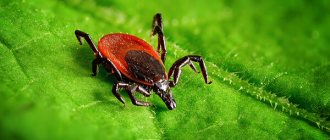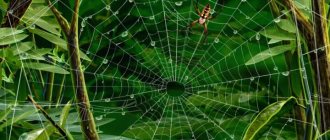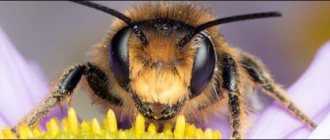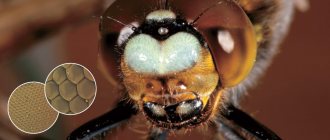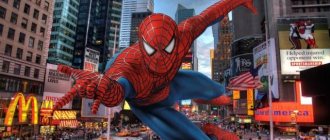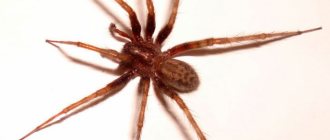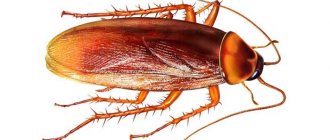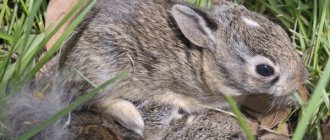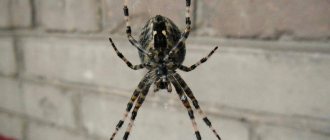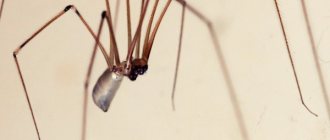Number of eyes in spiders
A striking difference between spiders and insects is the number of legs, there are always 8 of them. The same cannot be said about the organs of vision. There is no exact number of spider eyes, the figure ranges from 2 to 8 pieces. The largest number of species have exactly eight of them, however:
- Caponiidae is a family of small spiders, most of whose representatives have 2 eyes. But during the development of individuals, the number of eyes may change;
Cute big-eyed jumping spider.
- Symphytognathates, Uloboridae have 4 eyes;
- Tubulars, Spitters have 6 eyes;
- There are species, mainly inhabitants of dark caves, that are completely devoid of visual organs.
Associations
Looking at photos of amazing creatures, you get the feeling that they came from other planets. Their eyes differ in functionality and size.
With the help of modern cameras, you can see the color up close, as well as the location of the eyes on the body. Some have one row, others three, or even four.
By the way, on our website thebiggest.ru you can find out what the largest spider in the world is.
The science that studies these mysterious and slightly terrifying creatures is called arachnology. Brave people study them, since most residents of cities and towns are afraid and have a negative attitude towards arachnid creatures. For some, it is not even the spider itself that causes irresistible fear, but even its image. They are widely represented in culture, and their images are found on vases of the Sumerian kingdom and on the walls of the tombs of Ancient Egypt. The editors of TheBiggest.ru website ask all people who care about spiders to write a comment about this article. How much do you like or dislike spider eyes and do you find them unpleasant and scary? And below we will post some more beautiful photos of spider eyes.
That's all! But for those who don’t get enough, on our Zen channel we continue to publish photos of spider eyes.
Features of the organs of vision
At least 2 or 8 eyes have operating features. To ensure they work in unison and give a complete overview, they are separated and have different functions.
Primary eyes
Spider eye: 1. Muscles 2. Retina 3. Lens
The primary ones are most often the main pair, which is located straight. They have clearly defined edges, but they are motionless. The primary eyes have several functions:
- collection of parts;
- focusing on an object;
- image tracking.
The latter is possible due to the fact that the spider's eyes have muscles that move the retina.
Secondary eyes
Spider eyes.
They are located next to the primary ones and can be located on the sides, in the middle or in the second row. Their main functions depend on the type of spider, but the general meanings are:
- motion capture;
- hazard analyzer;
- enhance vision in low humidity conditions.
Compound eyes
Not all types of spiders have them, only some have them left over from their ancestors. The main function is to notice and reflect light. Due to them, there are no blind spots for the animal.
Types of spiders.
Visual system
In the process of evolution, different types of arachnids have developed a special vision structure. Hunting techniques and lifestyle depend on how many eyes the animal has.
Spiders that hunt by weaving webs have poor eyesight. More active hunters see much better. Basically, visual elements are represented by four pairs , arranged in 2 rows. The need for a large number of eyes is explained by the animal’s lifestyle. Arachnids have access to a 360-degree view.
However, in nature there are varieties that have 12 eyes, but there are also those who make do with one pair of visual elements.
However, these individuals also fully exist, because in nature every little detail is thought out.
How do spider eyes work?
The spider's eyes provide them with excellent visibility and good quality of vision. Some individuals are even sensitive to ultraviolet light. Interestingly, the mechanism works the other way around:
- first, the lateral organs of vision are turned on, which see the victim or danger for a long time;
- then the primary eyes are turned on, which focus on the object and analyze, regulating further actions.
In fact, the spider first catches movement with its side eyes, and then turns to look close-up with its main ones.
Scorpios: lifestyle
These arthropods are most often found in regions with tropical climates. Some species are diurnal, but the vast majority are nocturnal hunters. They prefer to hide from the scorching heat and hide under stones, snags and other secluded places during this period.
This is partly due to their imperfect vision. They can only notice danger at close range, and are better suited to hunting at night. But this is not only due to the specific features of vision. It doesn’t matter how many eyes a scorpion has (photo below) - they do not play a decisive role in capturing prey. It is believed that the main merit of precise attacks is the sensitive sensors on their paws.
Circular positioning of the legs gives the scorpion the opportunity to feel the smallest vibrations of the soil from all sides. Based on the speed of propagation of such signals (the nearest paws sense them earlier), it determines the exact location of the prey. The eyes play a secondary role in this. It has been noticed that if a scorpion and a victim are separated by a barrier in the form of a thin crevice, it will not be able to attack it even at close range. In this case, soil signals from the movement of prey do not reach its sensitive paws.
Virtues of vision
Spider with 8 eyes.
Spiders, thanks to their vision, have many advantages over other animals. The advantages are:
- the detail is better, people have weeks;
- ability to look at a picture close-up;
- good quality of vision in ultraviolet;
- ability to monitor prey around;
- Accurate jumping and movement in the grass, thanks to the ability to determine distance.
Simple and complex vision of arthropods
Insects have the most developed vision. In this regard, the eyes of arachnids are often called simple. In developed representatives of insects - bees, dragonflies, flies and the like - compound eyes have a facet structure. The structural visual unit is the ommatidia. These, in fact, make up a complex optical system. Located side by side, they form a visual complex. The ommatidium consists of a biconvex lens (cornea), under which there is a transparent cone, similar in properties to the lens.
Links[edit]
- "Catalog - Mendeley". www.mendeley.com
. Archived from the original on March 24, 2012. Retrieved May 4, 2022. - Jump up
↑ O'Connor M, Nilsson DE, Garm A (March 2010).
"Temporary properties of the lens of the box jellyfish Tripedalia cystophora". J. Comp. Physiol.
.
196
(3):213–20. DOI: 10.1007/s00359-010-0506-8. PMC 2825319. PMID 20131056. - Meyer-Rokhov V.B.; Reid W. A. (1993). "Are the head structures in the Antarctic nemertean Parborlasia corrugatus really eyes?" Fabric and cell
.
25
(1): 151–157. DOI: 10.1016/0040-8166 (93) 90072-S. PMID 18621228. - "Eye (invertebrate)." McGraw-Hill Encyclopedia of Science and Technology
.
6
. 2007. p. 790. - Vicki J. Martin (2002). "Photoreceptors of Cnidarians" (PDF). Archived from the original (PDF) on 10/05/2013.
- Zieger V, Mayer-Rochov V. B. (2008). "Understanding the head eyes of pulmonate gastropods: a review". American Malacological Bulletin
.
26
(1–2): 47–66. DOI: 10.4003/006.026.0206. S2CID 86083580. - Murphy, Richard S. (2002). Coral Reefs: Cities Under the Sea
. The Darwin Press, Inc. p. 25. ISBN 978-0-87850-138-0. - Blest, A.D.; Earth (1997). "Physiological optics of Dinopis Subrufus
L.Koch: a fish-eye lens in a spider."
Proceedings of the Royal Society
(196): 198–222. - ^ ab C. Bitsch and J. Bitsch (2005). "Evolution of eye structure and arthropod phylogeny". In Stefan Koenemann & Ronald Jenner (eds.). Relationships between crustaceans and arthropods
.
Crustacean problems. 16
. CRC Press. pp. 185–214. ISBN 978-0-8493-3498-6. - Martin Wilson (1978). "Functional organization of locust ocelli". Journal of Comparative Physiology
A.
124
(4):297–316. DOI: 10.1007/BF00661380. S2CID 572458. - Charles P. Taylor (1981). "The contribution of compound eyes and ocelli to locust flight control: I. Behavioral analysis". Journal of Experimental Biology
.
93
(1):1–18. Archived from the original on December 25, 2007. - ↑
Gert Stange and Jonathon Howard (1979).
"Ocellar dorsal light response in the dragonfly". Journal of Experimental Biology
.
83
(1):351–355. Archived from the original on December 17, 2007. - Eric J. Warrant, Almut Kelber, Rita Wallen, and William T. Wislo (December 2006). "Ocellar optics of night and day bees and wasps." Structure and development of arthropods
.
35
(4): 293–305. DOI: 10.1016/j.asd.2006.08.012. PMID 18089077. CS1 maint: multiple names: list of authors (link) - Richard P. Berry, Gert Stange, and Eric J. Warrant (May 2007). "Shape vision in insect dorsal ocelli: anatomical and optical analysis of the dragonfly median ocelli". Vision Research
.
47
(10):1394–1409. DOI: 10.1016/j.visres.2007.01.019. PMID 17368709. S2CID 14590003. - ↑
Joshua van Cleef, Andrew Charles James and Geert Stange (October 2005).
"Spatiotemporal white noise analysis of photoreceptor responses to UV and green light in the dragonfly middle ocellus". Journal of General Physiology
.
126
(5):481–497. DOI: 10.1085/jgp.200509319. PMC 2266605. PMID 16260838. - Richard Berry, Joshua van Cleef and Geert Stange (May 2007). "Mapping of visual space by the lateral ocelli of a dragonfly." Journal of Comparative Physiology
A.
193
(5):495–513. DOI: 10.1007/s00359-006-0204-8. PMID 17273849. S2CID 25806901. - ↑
Joshua van Cleef, Richard Berry and Geert Stange (March 2008).
"Directional selectivity in the simple insect eye". Journal of Neuroscience
.
28
(11):2845–2855. DOI: 10.1523/JNEUROSCI.5556-07.2008. PMC 6670670. PMID 18337415. - Geert Stange, R. Berry and J van Cleef (September 2007). Design concepts for a new orientation sensor for micro-air vehicles based on dragonfly eye vision
.
3rd US-European Micro Air Vehicle Systems Competition and Workshop (MAV07) and European Flying Aircraft Conference and Competition (EMAV2007). 1
. pp. 17–21. - Mueller, C. H. G.; Rosenberg, J; Richter, S; Meyer-Rokhov, V.B. (2003). "The compound eye of Scutigera coleoptrata (Linnaeus, 1758) (Chilopoda; Notostigmophora): a new ultrastructural study that adds support for the Mandibulata concept." Zoomorphology
.
122
(4):191–209. DOI: 10.1007/s00435-003-0085-0. S2CID 6466405. - Meyer-Rohi, Victor Benno (1974). "Structure and functions of the larval eye of the Perga sawfly." Journal of Insect Physiology
.
20
(8):1565–1591. DOI: 10.1016/0022-1910 (74) 90087-0. PMID 4854430. - R. Finkelstein, D. Smouse, TM Capaci, A. C. Spradling & N Perrimon (1990). "The orthodenticle gene encodes a novel homeodomain protein involved in the development of the nervous system and ocular structures of Drosophila". Genes and Development
.
4
(9):1516–1527. DOI: 10.1101/gad.4.9.1516. PMID 1979296. CS1 maint: multiple names: list of authors (link) - ↑
Adriana D. Briscoe and Lars Chittka (2001).
"The Evolution of Color Vision in Insects". Annual Review of Entomology
.
46
: 471–510. DOI: 10.1146/annurev.ento.46.1.471. PMID 11112177. - ^ab Markus Friedrich (2006). "Ancient mechanisms of visual development based on a comparison of gene networks controlling the larval eye, ocellus, and compound eye specification in Drosophila
."
Structure and development of arthropods
.
35
(4): 357–378. DOI: 10.1016/j.asd.2006.08.010. PMID 18089081.
Nutrition
The main diet consists of insects of different sizes. The spider's trapping nets catch flies, wasps, hornets, grasshoppers, locusts, caterpillars, and butterflies. Snakes, frogs, toads, and mice get entangled in large, strong webs.
Cross spider
There is no internal digestive system, food liquefaction occurs externally. The spider bites the victim, injects poison that paralyzes the muscles and immobilizes the prey. The cross releases saliva into the insect’s body, envelops it in a web, and waits for several minutes. In 5-20 minutes, the insides of the prey turn into a liquid mass, which the predator sucks up.
Basics
The tarantula's body is divided into two parts - the cephalothorax and abdomen. The cephalothorax contains the main central control organ of the spider - the brain. It is not for nothing that wolf spiders are called one of the smartest arachnids, because their brain volume occupies approximately 30% of the total cephalothorax space!
Four pairs of legs covered with fine hairs are also attached to it. The abdomen of the tarantula is also covered with them. This is his secret weapon.
In case of threat, the tarantula spider rises on its hind legs, and with its front legs it quickly, quickly scrapes off these fibers, which, when they fall on an enemy, say, on a person, cause him an unpleasant itch, like glass wool. But this is not as dangerous as it might seem, the irritation goes away quite quickly.
Nutrition
The main diet consists of insects of different sizes. The spider's trapping nets catch flies, wasps, hornets, grasshoppers, locusts, caterpillars, and butterflies. Snakes, frogs, toads, and mice get entangled in large, strong webs.
Cross spider
There is no internal digestive system, food liquefaction occurs externally. The spider bites the victim, injects poison that paralyzes the muscles and immobilizes the prey. The cross releases saliva into the insect’s body, envelops it in a web, and waits for several minutes. In 5-20 minutes, the insides of the prey turn into a liquid mass, which the predator sucks up.
If I don’t eat it, I’ll bite you!
The structure of the tarantula has one more feature - huge chelicerae. These are the "jaws" of the spider. With them he captures prey and injects poison.
The tarantula's digestive system consists of two stomachs, as well as an intestine and a digestive gland - the liver.
The circulatory system of a tarantula is a tube with a branched network of vessels extending from it, through which a clear liquid flows - the so-called hemolymph.
The tarantula breathes with the help of special holes in the exoskeleton - spiracles. Through them, air enters the spider's lungs, which also have an unusual structure. They are also called pulmonary books, since one of the walls of each of the two lungs is folded like book pages.
Although the tarantula does not spin webs, it does have arachnoid glands. He lines the burrow with this web, and the female weaves a cocoon for her eggs.
